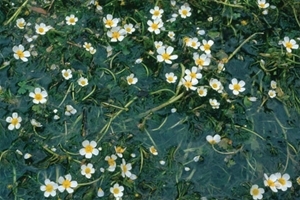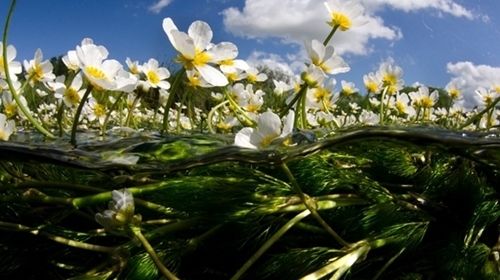This work was made possible with the kind support of The G & K L B Boyes Charitable Trust
Key points
- Water crowfoot is under threat and salmon populations are declining.
- This research consisted of:
- A catchment-wide study to identify what habitat characteristics (e.g. plants, flow, depth) have the strongest influence on young salmonids.
- A field experiment whereby the abundance of water crowfoot was manipulated to identify fish responses to low, medium and high plant cover.
- The scientists found that high coverage of water crowfoot in summer supports more, and better growing, young salmonids.
- Better supplies of prey were found in areas of high coverage of water crowfoot, allowing successful foraging and reducing competition between salmon and trout in the same areas of river.
- We can help conserve salmon and the wider river ecosystem by making sure populations of water crowfoot are carefully maintained.
This research was conducted during a PhD by Dr Jessica Marsh and resulted in the publication of three scientific papers (listed at the bottom of this summary). The PhD was supervised by GWCT Fisheries Department and the Queen Mary University of London, and funded by G & K Boyes Charitable Trust.
View Visual Summary →
Background
 Atlantic salmon (Salmo salar) and brown trout (Salmo trutta) are known as salmonids because they are part of the Salmonidae family of fish. All salmon and many brown trout are migratory, spending part of their lives in fresh water and part in the sea.
Atlantic salmon (Salmo salar) and brown trout (Salmo trutta) are known as salmonids because they are part of the Salmonidae family of fish. All salmon and many brown trout are migratory, spending part of their lives in fresh water and part in the sea.
At least the first year of their lives are spent in rivers, feeding on freshwater invertebrates before migrating out to sea as ‘smolts’. They spend at least a year in the North Atlantic before migrating back to their native rivers to breed.
Populations of Atlantic salmon have undergone significant declines in the last few decades. It is difficult to explain why, because their complicated life cycle covers huge distances in rivers and oceans. However, GWCT research in a lowland river suggests that larger salmon smolts are more likely to return from their marine journey than smaller individuals.
The body condition and size of smolts at the time of migration is strongly influenced by river habitat and resources in their first summer. Therefore, it is important to know what type of habitat is best for young salmonids so that river managers can provide the right conditions.

Aquatic plants like water crowfoot are suspected to be a key part of fish habitat in lowland rivers.
Water crowfoot (Ranunculus spp.) is an aquatic member of the buttercup family found in clean gravelly lowland watercourses, especially chalk streams. It anchors to the riverbed and forms thick canopies of trailing foliage. Its fine feathery leaves trap silt and detritus, attracting freshwater invertebrates and animals such as salmon that prey on the invertebrates. Its flowering branches form a floating mat on the surface and its dense vertical structure in the water column cause variations in the depth, speed and flow of water in the river. Water crowfoot is a key component of aquatic ecosystems, but it is under threat from low flows, pollution and physical loss from leisure activities, weed cutting and swan grazing.
The research topics and aims can be summarised as follows:
- Broad habitat study – Identify which lowland river habitat features had the strongest influence on young salmonid population density (Paper 1)
- Water crowfoot experiment – Identify, quantify and explain the benefits of water crowfoot to young salmonids (Papers 2 and 3)
What they did
The study took place on the River Frome, which is a lowland chalk stream in Dorset with notable populations of salmonids and water crowfoot. Two sets of methods were used in this research and overlapped in time:
 Left: Jessica Marsh surveying the riverbed with a bathyscope in a section with low cover of water crowfoot.
Left: Jessica Marsh surveying the riverbed with a bathyscope in a section with low cover of water crowfoot.
Right: Electro-fishing survey of a high cover section.
1) Broader habitat study
From 2015 to 2017 the authors collected fish and habitat data from twenty 100m sections of river spread throughout the catchment every year during August and September. Young salmon were caught using electro-fishing, then measured, weighed, fitted with a unique identifying tag and returned safely to the same section of the river. Freshwater invertebrates in the river were collected and analysed to estimate prey biomass, and physical characteristics of the river such as water depth, velocity and plant cover were recorded. Spawning areas and the distance from the tidal zone of the Frome were also noted.
2) Water crowfoot experiment
To investigate the benefits of water crowfoot, a two-year experiment from 2016-2017 was set up on a separate branch of the River Frome where aquatic habitat was relatively uniform to begin with. Three 100m sections were identified and three 20m lengths were selected within each. In spring, the water crowfoot at each site was assessed and then carefully lifted and redistributed to create three different coverage zones of water crowfoot:
- Low cover: <10% cover of water crowfoot
- Medium: 30-40%
- High: >60%
The experimental sites were visited on four occasions between June and October each year. For this study, the same types of surveys were performed as outlined in Study 1, but with two new elements. Firstly, stomach contents of a sample of fish were obtained using a harmless flushing technique to determine diet quantity and composition. Secondly, tagged fish were recaptured at subsequent surveys to measure growth.
The authors carried out statistical analysis of data to identify relationships between habitat features and salmonids.
What they found
The broad catchment-wide habitat study found that there were more young salmon in sites with more plant cover in the river, as well as sites closer to where spawning had taken place, and at sites positioned in the lower part of the river. More young trout were found in sites that had more variable velocity, i.e. a mixture of fast and slow flows.
The water crowfoot experiment found that the plant is strongly associated with a good diversity of water depth and velocity, and increased prey quantity. The following direct and indirect impacts on salmonids were identified:
- High coverage of water crowfoot in summer can support more, and better growing, young salmonids.
- High quality supplies of prey were found in areas of high coverage of water crowfoot, allowing successful foraging and reducing competition between salmon and trout in the same areas of river.
- Faster flows and shallower depths were positively related to higher salmon abundance.
- Increased prey biomass was positively related to increased salmon growth.
What does this mean?
Overall, the findings suggest that water crowfoot is very important as a habitat for both young salmon and trout. These benefits come directly from the plant itself, and also in the way it shapes river habitats.
High coverage of water crowfoot may directly increase numbers of salmon because it offers excellent shelter. The floating canopy and complex underwater structure attracts young salmonids because it makes it harder for aquatic and avian predators to exploit them. Water crowfoot shields fish from extreme summer temperatures and allows them to rest outside of fast-flowing areas. The dense foliage also hides them from view of fellow fish, which reduces stress from competition and allows more fish territories to be held in a relatively compact space.
Water crowfoot creates a range of velocities in the river, which indirectly benefits salmon. Water flows faster when it is diverted around stands of water crowfoot, and faster flowing areas were more abundant in salmon. Salmon may be attracted to fast-flowing areas where there is a higher abundance of drifting prey, such as mayfly and blackfly larvae.
The growth rate of young salmon is a crucial factor in the ability of these fish to reach the smolt stage, migrate to sea and survive their marine journey. Salmon growth is highest in areas rich in invertebrate prey, which in turn is associated with water crowfoot. The plant also creates a diversity of flow speeds in the river, leading to areas of faster flow, where biomass of invertebrate prey was found to be higher. Salmon therefore benefit indirectly from water crowfoot because it provides flow diversity and an excellent source of prey.

Conclusion and forward look
Water crowfoot has clear benefits for young salmon and trout: it is associated with more, better-growing fish. The plant itself, and the role it performs in shaping in-river habitats, are both important.
Conservation of water crowfoot through sensitive river management is essential in order to maintain a healthy population of young salmonids, and to preserve the wider ecosystem that they live in.
The experimental part of this research has shown that the quantity of water crowfoot cover can be increased by planting. This could be a plausible management tool to benefit salmonids. GWCT Fisheries scientists plan to test this by undertaking a water crowfoot planting project on a meaningful scale in the River Frome catchment. They will identify areas of river downstream of important spawning sites that have low coverage of water crowfoot. The water crowfoot population will be increased by planting, with the aim of boosting the productivity of salmon and trout smolts.
Read the original abstracts
Please email Rasmus Lauridsen (rlauridsen@gwct.org.uk) if you would like to receive the papers in full.
- Marsh, J.E., Lauridsen, R.B., Gregory, S.D., Beaumont, W.R.C., Scott, L.J., Kratina, P. & Jones, J.I. (2020). Above parr: Lowland river habitat characteristics associated with higher juvenile Atlantic salmon (Salmo salar) and brown trout (S. trutta) densities. Ecology of Freshwater Fish, 29:542–556.
- Marsh, J.E., Lauridsen, R.B., Gregory, S.D., Kratina, P., Scott, L.J., Cooling, D. & Jones, J.I. (2022). High summer macrophyte cover increases abundance, growth, and feeding of juvenile Atlantic salmon. Ecological Applications, 32:e2492.
- Marsh, J.E., Jones, J.I., Lauridsen, R.B., Grace, J.B. & Kratina, P. (2022). Direct and indirect influences of macrophyte cover on abundance and growth of juvenile Atlantic salmon. Freshwater Biology, 67:1861–1872.